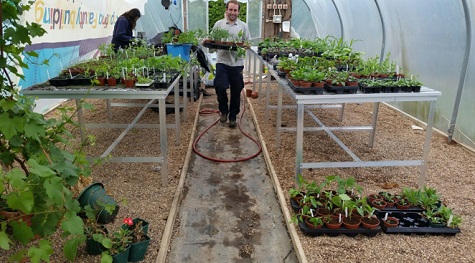Back in 2006, Coventry University, in common with other higher educational institutions and local authorities, were continuing the age old tradition of “seasonal” bedding schemes with such winter plants as polyanthus and pansy’s being replaced each June with geraniums, salvias and begonias etc. In the summer of 2006, as a bit of fun, four courgette plants were added to a square planter otherwise traditionally planted for summer. This caused quite a stir amongst the staff and students of the University with the garden team receiving many questions as to “why?” and “can we eat the fruit?”
What was noted by the gardeners was that people suddenly wanted to engage in conversation with the team and this simple act of talking about four courgette plants lit a fuse that ultimately would become the edible garden that we see today.
This initial reaction to the courgettes led the following year to the garden team designing and planting a summer bedding scheme purely out of vegetables with the aim of producing an attractive and productive planting that would continue to engage with the staff and students.
The interest in this “strange” planting increased throughout the summer of 2007 and it was decided that they would “take the plunge” into a full “edible garden” the next year. An area of lawn and overgrown shrub bed was earmarked as the most suitable site for the garden as it sat within the very heart of the campus and would be visible to the majority of people within the University community and the general public who transverse the grounds on their way into town.
During the winter of 07/08 the shrubs were removed and the soil improved with plenty of compost and manure. “Bug hotels” were made and installed by the team and a simple design of edibles and nectar rich flowers was put together and planted in the spring of 2008. Much of the produce was grown in-house by the team at their nursery.
Although very popular it soon became apparent during the early years that it was just too small for the interest that it generated and that they would need to think bigger. So over the intervening years the garden has undergone two further expansions, first in 2012 and then again in 2017. It now boasts 13 dedicated raised beds for the growing of vegetables, soft and hard trained fruit lines, raised herb beds and borders choked full of plants for pollinators. A bespoke notice board and an ornamental beehive were added last year, and more seating will be included this summer.
The nearby raised brick borders which mark the entrance look stunning, as does the 270 year old olive tree which welcomes visitors into the garden.

The first enlargement of the garden in 2012, showing the “beehive” design to the herb garden

Produce for the edible garden being grown at the grounds nursery
In 2013 as part of the “central campus” the garden was awarded Green Flag status for the first time - an award it maintains to this day.
The grounds team have also found it to be a very useful educational tool for their apprenticeship scheme with the apprentices doing much of the propagating and growing of the stock at the nursery, providing an excellent work-based learning opportunity in good horticultural techniques.
The original concept for the garden was to create a green space that would help people to engage with the land between the buildings, to encourage them to stop, relax and take five minutes out of their busy day, maybe pick some produce to take home or even to sit and revise in peace. The team feels that the garden has achieved this and more.
A walk through the garden now and vistors will experience a garden that has developed in the last decade into a fine example of how to combine the practical growing of produce within a very attractive setting, and highly suitable for biodiversity in the built environment.
Walking through the garden today, people will see climbing squashes and beans, kale, carrots, parsnips, fennel and salad crops amongst many other varieties of edibles, bumblebees and other pollinators busy bustling around the many flowering plants and of course many members of the university staff and students using the garden not only for the produce but, far more importantly, for the opportunity to engage with nature, to relax and to meet colleagues or friends for lunch.
This vibrant space sat within a busy and bustling campus has managed to engage people like no other garden around the campus. It has been used by students for research and local schools have visited for ideas for their own edible gardens - but more important than all that, it just makes people happy to be outside and proud to be part of the University community.